4 Sexual Selection
STUDENT LEARNING OUTCOMES
At the end of this chapter you should be able to:
- Summarize the theory of sexual selection and contrast it with natural selection
- Describe the connection between anisogamy and sexual selection
- Recall examples of sexually dimorphic traits under the influence of sexual selection
- Explain how sexual conflict could result in the coevolution of female and male genitalia
- Debate the biological and cultural underpinnings of sexually dimorphic traits in humans
Uncovering the mystery of self-sacrificing male spiders
While completing her graduate studies at Cornell Maydianne Andrade studied red-back spiders (Latrodectus hasselti) and asked the question: why would a male somersault onto the female’s fangs ensuring their death? Andrade found that this is part of their courtship and although it leads to the death of the male, females are more likely to copulate with males that engage in this courtship. More importantly successful copulation is dependent upon this death-inviting behavior. Therefore somersaulting to their death is the best way to ensure mating success because, without cannibalism by the female, the male redbacks would never be able to pass on their genes to the next generation (Andrade, 1996; 2003). Dr. Andrade has continued her research and has become the expert on sexual selection and mating behaviors in widow spiders at the University of Toronto Scarborough.
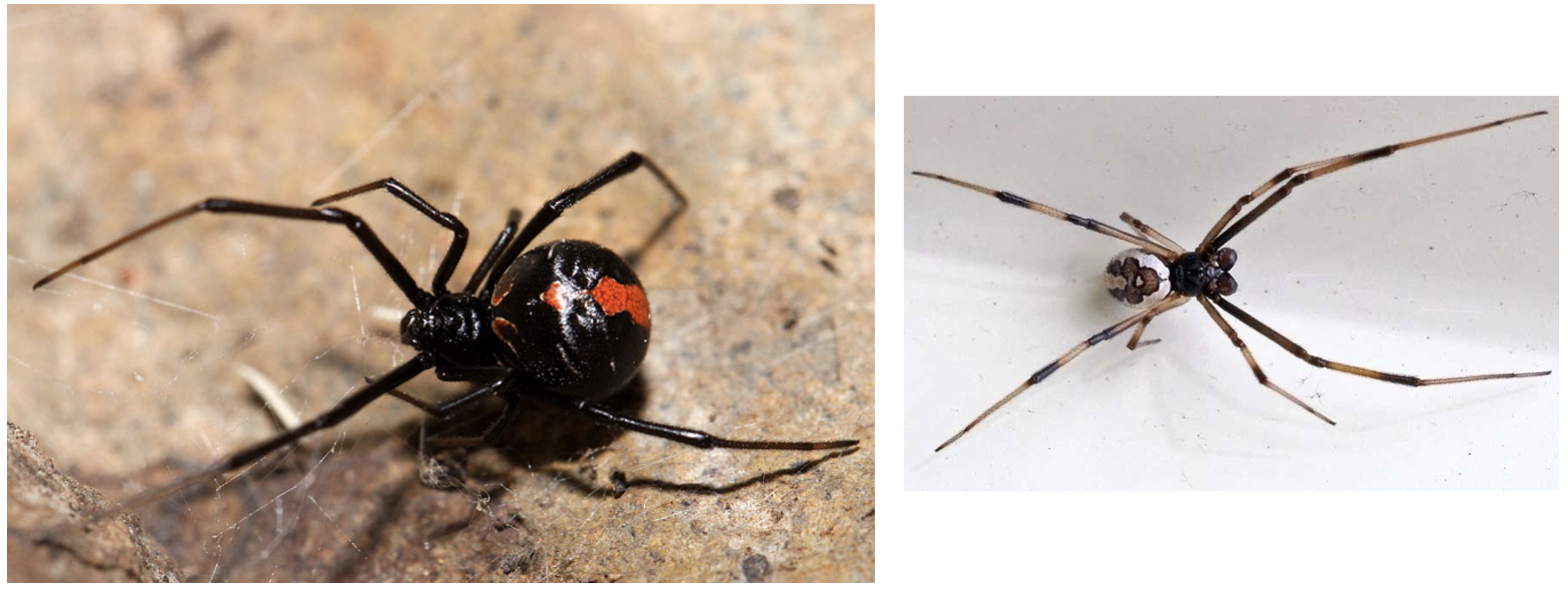
What is sexual selection?
Instead of natural selection as the driving force resulting in the observed death-wish-behavior of male red-backed spiders, a different type of selection – sexual selection has been influencing this trait. Darwin found this type of behavior as well as other traits that seemingly defied natural selection as perplexing. For example, he notoriously was confounded by the male peafowl’s (peacock) elaborate feathers and loud calls because he thought such flashy traits would reduce an individual’s fitness. Darwin recognized the female peafowl’s coloration was much duller, and they did not make loud calls. The striking difference between the peafowl sexes is an example of sexual dimorphism. Dimorphism was first documented by Wallace who observed Papilio memnon butterflies, whereby the females looked very different from the males (Wallace 1865). But why do females look and act differently than males in many species? It stands to reason that such conspicuousness in males would significantly increase the risk of predation. Under natural selection, these traits should not evolve because they appear to reduce fitness yet they persist.
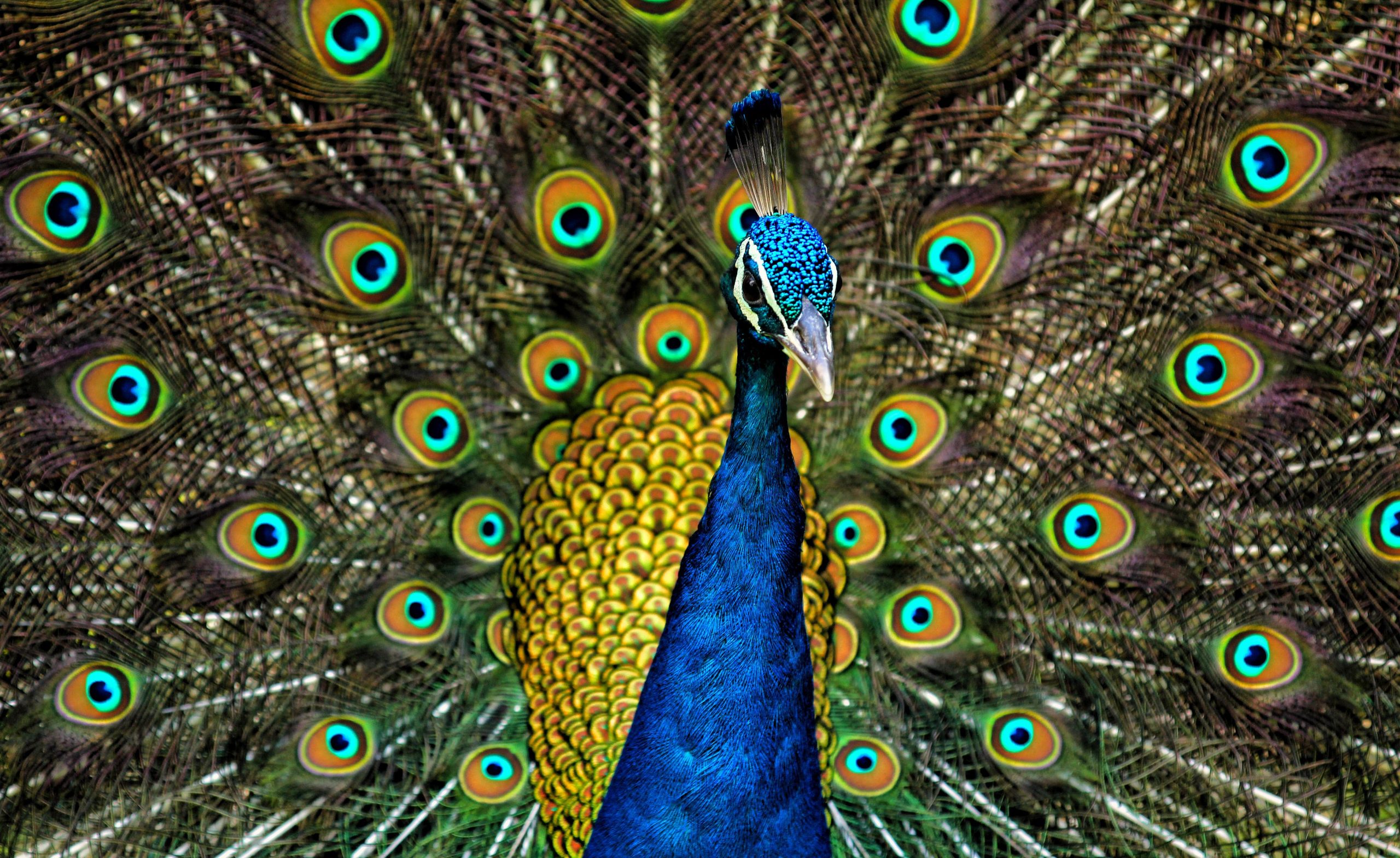
After much thought and accumulation of data Darwin understood the differences among peafowl sexes in coloration and behavior were examples of characteristics that had evolved thanks to what he called “sexual selection” rather than natural selection. He put forth this theory in his book “The Descent of Man, and Selection in Relation to Sex” (1871). Darwin explained there is variation among males, and some males are better than others at attracting mates in rivalry with other males, and “would consequently have left a larger number of offspring to inherit their newly-acquired beauty.” Variation in coloration, ornament, and or behavior could provide an advantage in acquiring mates and if heritable, these traits would be passed on at a higher frequency. In this way sexual selection is similar to natural selection however it is explicitly driven by competition for mates and preferences in choosing mates for reproduction. Thus sexual selection is different from natural selection because “the males have acquired their present structure, not from being better fitted to survive in the struggle for existence, but from having gained an advantage over other males, and from having transmitted this advantage to their male offspring alone” (Darwin, 1871). As Weismann points out individuals with certain sexually dimorphic traits can benefit because they “gain an advantage in the struggle for existence by their new characteristics” (1872). Sexual selection focuses completely on increasing fitness through successfully reproducing with a mate. When individuals differ in their reproductive ability and there are a limited number of opportunities to mate with another this creates competition, and if these differences are heritable then selection is at work. Shuker (2010) remarks that “sexual selection is the relationship between a trait and its effect on fitness through sexual competition.”
Sexually selected traits persist even when they may result in increased predation or harmful risky behavior because ultimately mating success is more important than living
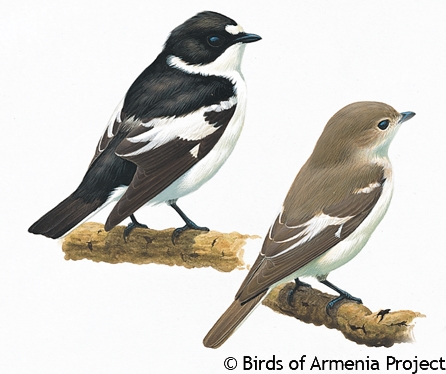
long. These traits increase an individual’s chance of attracting mates and so are sexually selected. There are numerous examples of sexually dimorphic traits which can be explained by sexual selection such as the white patch on the forehead of a male collared flycatcher (Ficedula) pictured here. Female collared flycatchers lack the patch and have a dull brown and white plumage. They are more inconspicuous. It turns out that the size and brightness of the male’s forehead patch is positively related to their reproductive success so that is likely the reason it persists (Gustafsson, Qvarnström, and Sheldon 1995).
Darwin suggests two avenues for the evolution of sexually dimorphic traits
1. Mate choice. Individuals of one sex select among individuals of the other sex (also known as intersexual selection). How an individual chooses a mate can be based on various signals from the suitor. These factors can be taken as indications of genetic superiority, direct benefits provided to the mate, or they evoke a positive association known as sensory bias. Those of one sex can showcase signals or provide benefits in various ways.
Examples of traits considered to be sexual selection factors involved in mate choice.
- Ornamental traits
- Example: the intense blue plumage of male Hainan blue flycatchers Cyornis hainanus, (Dale et al. 2015), or the ornamental skin folds found on female pipefishes (Nerophis ophidion) during spawning season (Rosenqvist 1990)
- Vocalizations
- Example: long, loud calls exhibited by Pacific tree frogs, Psuedacris regilla (Vélez and Guajardo 2021)
- Courtship displays to attract mates
- Example: dancing peacock spiders, Maratus (Girard, Elias, and Kasumovic 2015)
- Providing direct benefits to potential mates to persuade them to be chosen
- Example: male scorpionflies (Hylobittacus apicalis) bring prey items to females during courtship as “nuptial gifts” and if the item is not “large enough” she will reject him (Thornhill 1984)
2. Mate competition. When there is a limited number of mates, those of the opposite sex must compete with one another for the opportunity to gain access and mate with the other sex (also known as intrasexual selection).
Examples of traits considered to be sexual selection factors involved in competition.
- Aggressive displays
- Example: female gobies, Pomatoschistus minutus, exhibit aggressive female-female interactions when there are a limited number of males to mate with (Kvarnemo, Forsgren, and Magnhagen 1995); in territorial barking geckos (Ptenopus garrulus) larger males exhibit more aggressive behavior and are more likely to breed (Hibbitts, Whiting, and Stuart-Fox 2007)
- Physical combat
- Examples include: repeated sequences of ritualized grappling between male Gila monster lizards, Heloderma, (Gienger and Beck 2007); male big horn sheep fighting with one another for access to females, body mass and horn size are positively correlated with reproductive success of mature males (Coltman et al. 2002)
- Acquiring and defending territories that members of the opposite sex use
- Example: red-winged blackbird, Agelaius phoeniceus, females prefer males defending superior territory (Yasukawa, Blank, and Patterson 1980)
- Sperm competition and baculum structure in species where females mate with multiple males
- Example: a meta-analysis of several bird species found that sperm competition favored larger males in dense populations, (Møller and Ninni 1998). Andre et al., (2020) found that in house mouse populations the rate of multiple paternity can reach up to 70% indicating strong male-male competition. They also found that male mice have a boney structure in their penis (baculum) which provides stimulation to the female reproductive tract and varies in width among males. Their research shows that baculum size covaries with cervix size and contributes to male reproductive success.
Two sexes have different selection pressures operating because of anisogamy
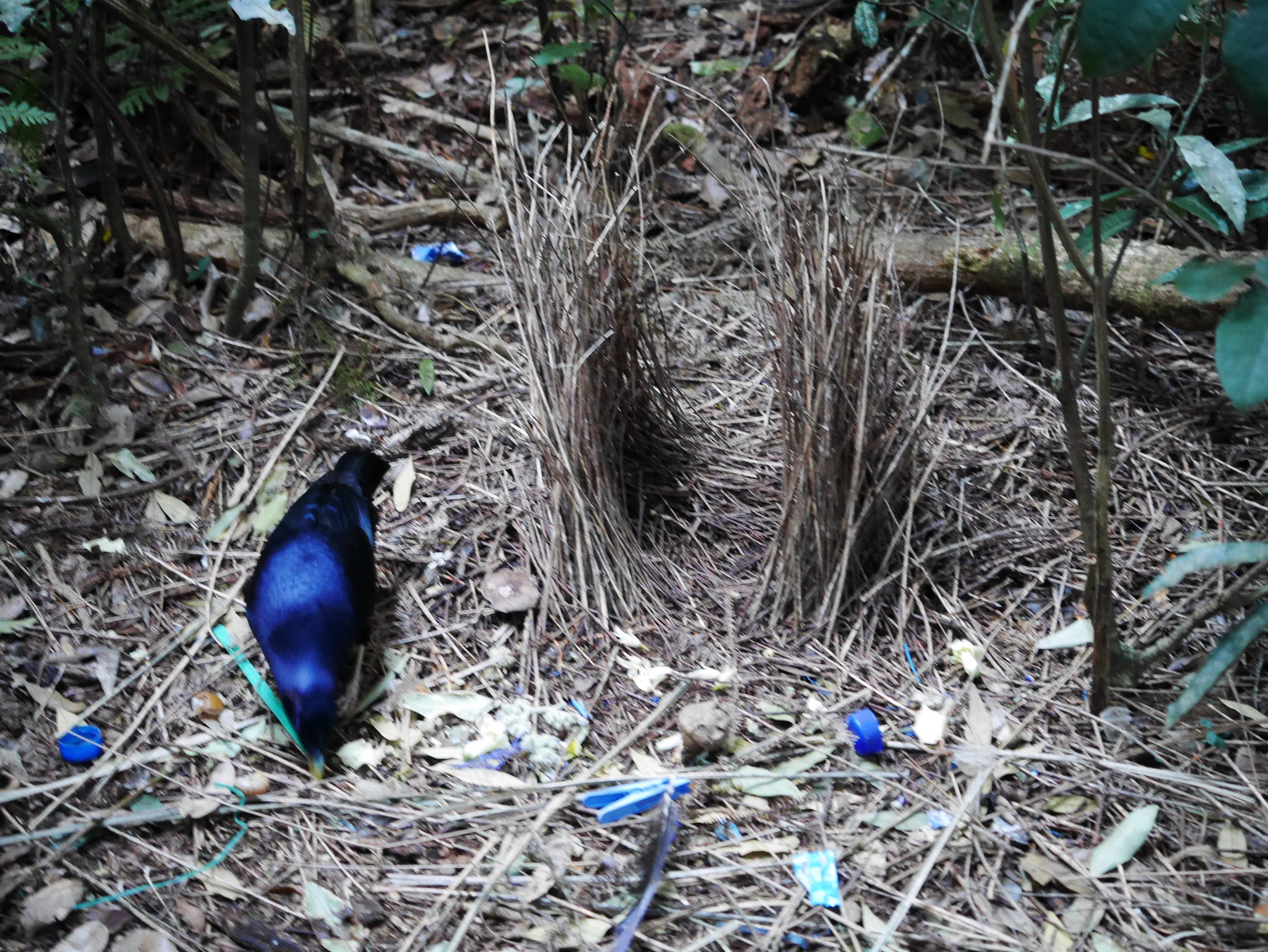
Both mate choice and mate competition avenues of sexual selection are attributable to anisogamy, whereby females produce fewer larger gametes compared to males (as discussed in the chapter on the Evolution of Sex). Every egg is much more valuable compared to sperm because of both its size and its relative scarcity. Anisogamy creates competition among males for access to females during mating and females are likely to be the choosier sex because of the investment they have made in their eggs (Bateman 1948). Therefore traits will evolve differently under sexual selection among the sexes. For example, the male Satin Bowerbird (Ptilonorhynchus violaceus) of eastern Australia (see image on right) engages in complex behavior involving multiple traits such as building, and decorating stick structures called bowers where they court females (Borgia 1985). According to Borgia (1995) “females exert strong preferences in mating, and only a small proportion of males achieve most of the matings. Males with high-quality bowers with symmetrical walls formed from thin, densely packed sticks, many decorations on their courts mate most.”
The roles can be reversed when the circumstances change- as in the case of pipefishes and seahorses where the males are more choosey and the females must compete with one another for mates (Vincent et al. 1992). More importantly, there has been a research bias towards only studying male behaviors and traits. This male-focused bias by past evolutionary biologists has skewed our understanding of sexual selection making it appear as though secondary sexual characteristics are only found in males and not in females (Cooper et al. 2019). However, new research examining female behavior and traits is producing findings expanding our understanding of this topic. For example, there are bird species in which females, like males, have noticeable dimorphic characteristics such as brightly colored plumage or pelage and elaborate ornaments as discussed by Clutton-Brock (2009). It is also notable that “females—just as males—typically benefit from having more than one mating partner” and “positive selection for mate acquisition may potentially be common in females” as in males (Fromonteil et al., 2023).
What about sexual conflict?
Sexual selection operates differently in females and males because of anisogamy. Sometimes because of these differences antagonistic coevoltion between the sexes occurs and traits that evolve in one sex have become harmful to individuals of the other sex. Holland and Rice (1997) posit that “intersexual conflict over mating rate will continually select for new, or more elaborate, traits in males that cause females to mate at a rate beyond their optimum, and for females to evolve counter-adaptations.” An example of intersexual conflict has been observed in ducks where their genitalia have coevolved in opposite directions (Brennan, Clark, and Prum 2009). Forced copulations (males forcefully mating with females unwilling to mate with them) are common among waterfowl and enhanced by males’ corkscrew-shaped penis. These forced copulations “result in overt sexual conflict between males and females to control fertilization…” and consequently, female waterfowl have evolved “…blind-ending pouches and a series of spirals that are opposite to the chirality of the corkscrew-shaped penis” (Brennan, Clark, and Prum 2009). Moreover, the counter-penile-shaped female vaginas have evolved despite “the indirect genetic benefit of being fertilized by preferred males” (Brennan and Prum 2015).
Q&A with Dr. Patty Brennan, Ph.D.
Associate Professor at Mount Holyoke University
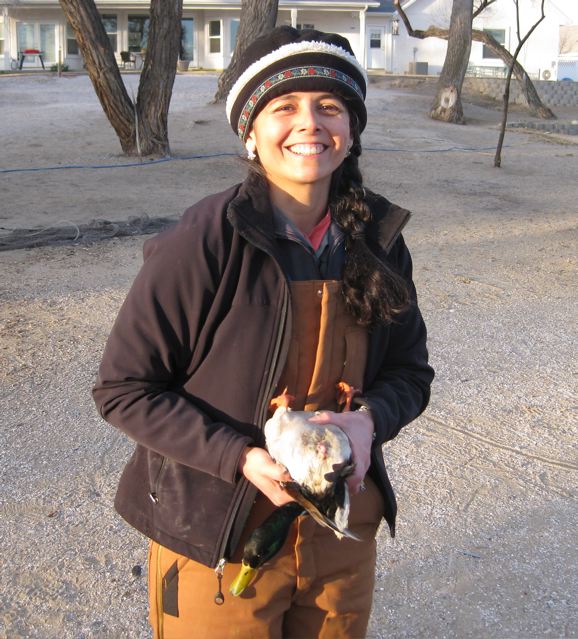
What drew you to studying sexual selection and specifically waterfowl genitalia coevolution? I find the idea that sexual behavior can drive so much amazing evolutionary change really compelling, and genitalia are an excellent example of how these dramatic changes can happen given their primary function during copulation. I became interested in bird genitalia after I realized that the birds I was studying for my PhD (tinamous) had penises. Since I had never even heard that some birds had penises, I wrote a postdoctoral proposal to investigate why birds had lost their penis, and why some of the species that kept them had such exaggerated morphologies. At the time I was not thinking about coevolution, but as soon as I dissected my first duck penis, I predicted that female ducks should have some interesting vaginas too, and when I looked that is exactly what I found. I realized right away that female genitalia were vastly understudied, and have been making an effort to look at both males and females ever since.
What have you enjoyed most about your research/fieldwork? Being the first person to open up a research area first studying tinamou reproductive behavior, and then genital coevolution in vertebrates has been very exciting! My recent research has expanded to look at female genitalia and clitoris morphology, and I enjoy being able to highlight the gaps, and then filling them in as I go along. Most amazing, I get to do this work at a women’s college, where my students are particularly excited to contribute to science that equalizes our understanding of females in nature.
What do you find most challenging about your career? The topic of my research can be difficult to discuss with some people who are uncomfortable with conversations that involve frank discussion of genital parts and sexual behavior. I try to mitigate this problem by doing a lot of outreach to make the point that genitalia and sexual behavior are integral and crucial parts of an organism’s biology and not something that we should have taboos about. I also had challenges with raising a family while trying to have a permanent job. I ended up prioritizing my family, and as a result, I spent several years in non-tenure track positions, before getting my permanent position now. It all worked out in the end, but it reminded me of the saying that we can have it all, just not at the same time. Being a Hispanic immigrant was difficult at times because of microaggressions, but I have become better at pointing out behaviors that are hurtful rather than internalizing them.
What advice do you have for future women scientists? Ask for a raise. Keep your friendships alive. Find projects that are exciting for you, but don’t let your life outside of academia suffer because of your scientific passion. Make the time to take care of yourself, be social, learn a new skill, practice a sport, whatever fills you up. If you have a partner, have difficult conversations about how to support each other in your chosen careers, and what you need from them, and be ready to renegotiate constantly. Trust yourself and look for senior allies wherever you are. Become familiar with your Title IX offices and the procedures to report behavior that is not appropriate. Support other women.
Sexually dimorphic traits in humans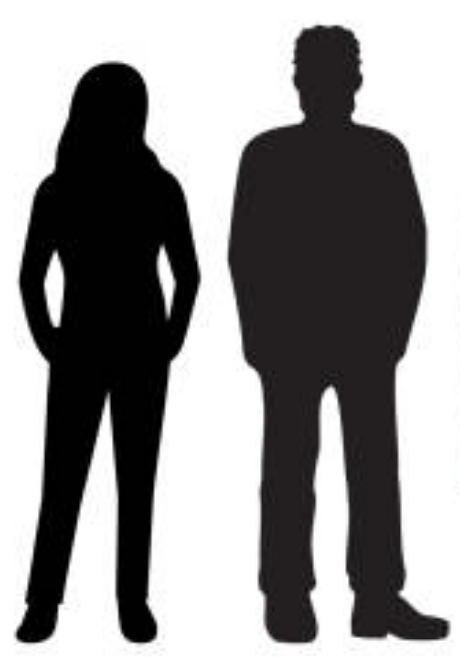
Adult women are different than men. Besides genitalia, several traits generally exhibit sexual dimorphism. Hormonal differences underlie these traits. Yet these differences are “on average”, there is significant individual variation, and not all individuals will conform to these patterns. Moreover, cultural gender norms augment the differences.
Traits in which adult females and males differ (on average).
Body hair: as mammals, we are covered in body hair but the “fine and short nature of our body hair renders most of it invisible…The retention of visible head, axillary, and pubic hair remains a conundrum for anthropologists and evolutionary biologists alike” (Ramsey et al. 2009). Overall, facial hair is less noticeable in women compared to men because androgens are involved in hair production. Lower DHT levels resulted in decreased facial and body hair (Imperato-McGinley et al. 1993).
Breast size: on average women have larger breasts than men. However, breast size and shape can vary significantly. A study by Anderson et al. (2013) examined 342,000 individual breast size measurements from 108 different countries and found the shape of the female breast varies to some extent depending on the country of birth.
Body fat composition: females have greater body fat composition than males (Wells 2007). Boulet et al. (2022) note that “a critical level of fat in women is necessary for menarche and for the recovery of menstrual cycles after energy restriction.”
Muscle mass: males have greater total lean mass than females (Wells, 2007) and females have a greater proportion of type I muscle fibers (Haizlip, Harrison, and Leinwand 2015). These are known as slow-twitch fibers and are often observed in greater abundance in endurance athletes.
Skeletal differences: females have lower bone mass density than males due to differences in the width/thickness of bone (yet gender-related differences in bone size are related, in part, to different types of physical activity) (Nieves et al. 2005). Lewis et al. (2017), comment that the “female pelvis tends to be wider and broader, with less prominent ischial spines… that allow for a wider pelvic aperture in females which functions as the birth canal, facilitating the passage of large-brained neonates.”
Another notable difference has been found in knee alignment, specifically in the quadriceps angle (Q-angle) which represents the angle formed by a line from the anterior superior iliac spine of the pelvis to the patella center and a line from the patella center to the tibial tuberosity (Livingston 1998). The Q-angle impacts the “quadriceps mechanism on the knee, it also gives an idea how the thigh muscles function to make the knee move, as well as how the knee patella tracks in the groove of the knee joint”… females have higher mean values (Khasawneh, Allouh, and Abu-El-Rub 2019). This is a risk factor for anterior cruciate ligament injury, explaining why women experience significantly more ACL tears than men (Harmon and Ireland 2000).
Auditory differences: females as a group have greater hearing sensitivity and greater susceptibility to noise exposure at high frequencies than males as a group (McFadden 1998).
Does sexual selection occur in human populations?
There are aspects of humans that fit the model of sexual selection of females being more choosy and males more competitive with one another for mates. This would lead to sexually dimorphic traits involved in reproduction. The investment in offspring through gestation and nursing is significantly greater for women than men. There is also evidence for sperm competition in men. Both are factors that influence sexual selection. Several lines of evidence support sexual selection as an important evolutionary force in humans (Puts 2010; Lindenfors and Tullberg 2011; Puts 2016). Arguments against the role sexual selection plays are made as well. Schacht and Kramer (2019) note that paternal investment by humans is significantly greater as compared to our closest relatives and rather than polygyny and/or polyandry that would drive male-male competition, monogamy is the rule rather than the exception. Overall, caution must be taken due to the complexity of human reproduction and to avoid stereotypes associated with the simple dichotomy of choosy women and competing men. There are a multitude of possible explanations for the persistence of sexually dimorphic traits.
Could the female orgasm be a result of sexual selection?
Humans are placental mammals, also known as eutherians, but the human reproductive tract is not entirely representative of all eutherians. Diversity in female sex organs and genitalia exists within the group. For example, elephant shrews lack a cervix and true vagina whereas anteaters and sloths have a utero-vaginal canal (Pavlicev, Herdina, and Wagner 2022). Many mammals have a duplex uterus consisting of two cornua that join distally into a single body such as mice, cats, dogs, and pigs. Interestingly some species exhibit genital variation within members. For example, cetaceans (dolphins, porpoises, and whales) have vaginas with muscular protrusions of the vaginal wall into the vaginal lumen that vary in number, shape, size, and positioning across species (Orbach et al. 2018). In many instances, natural selection is likely responsible for producing adaptations that increase fitness. However, when it comes to cetacean vaginas, Orbach et al., (2017) posit that the observed variation could have been “shaped by post-copulatory sexual selection”. Sexual selection is now widely recognized as an important selective pressure acting on genital morphology (Hosken and Stockley 2004; Simmons 2014; Sloan and Simmons 2019).
The female orgasm is not directly tied to reproductive success, unlike the male orgasm which always results in ejaculation. Shirazi et al. (2018) found in a recent survey of over 1,400 women, that over 20% never experience an orgasm during penile-vaginal intercourse. Furthermore, the majority of women surveyed reached orgasm without penile-vaginal intercourse but with assisted clitoral stimulation. Why might females experience orgasm without sexual intercourse? This is a debated topic and there are several hypotheses regarding the evolution of the female orgasm (see Lloyd 2005) but one in particular points to mate choice under sexual selection.
Research suggests that orgasm for women may signal a high-quality mate. Ellsworth and Bailey (2013) found that a woman’s orgasm frequency and intensity were related to partner ratings of monetary investment and level of physical protection. Additionally, surveys indicate that orgasm is the “most important single predictor of sexual satisfaction for women” (Kontula and Miettinen 2016). Thus females may choose to have repeated sex with males with whom they experienced orgasms based upon the induced associated pleasurable sensations. Gallup Jr., Towne, and Stolz (2018) found a direct link between sexual satisfaction by women and the intensity of their orgasms and how many orgasms they had per encounter. Sperm competition may also be a driving factor in the evolution of the human female orgasm. The female orgasm may have the ability to improve sperm transport in the female reproductive tract to promote fertilization. Pavličev and Wagner (2016) note that the female orgasm “also causes patterns of brain activation and hormone release associated with increased uterine contractions, lower uterine pressure, and movement of semen into the uterus”. Specifically, in addition to oxytocin, prolactin and luteinizing hormone surges accompany the human female orgasm which is similar to mammals that undergo copulation-induced ovulation, potentially linking the human female orgasm to an ancestral ovulatory function (Pavličev and Wagner 2016).
Sexual selection has played a significant role in a wide array of taxa, shaping various aspects of female biology, including mate choice, reproductive anatomy, behaviors, and communication. It has led to the evolution of traits and strategies that enhance a female’s reproductive success and ensure the transmission of her genes to the next generation.
Think, Pair, Share
Besides food what might be some examples of direct benefits that mates of one sex could provide to those of the limited sex during courtship?
Find examples of phenotypic traits that you predict to be under the influence of sexual selection. Provide reasoning to support your answer.
In species where both sexes exhibit bright coloration/ornamentation is sexual selection responsible? Why or why not?
Do you consider the theory of sexual selection to be controversial? Why or why not.
Deeper Questions
As Ah-King (2022) notes, “the history of sexual selection research shows prevalent male precedence—that research starts with the male-centered investigation”. Why might this have led to misunderstandings about sexual selection?
What aspects of human behavior might be explained by sexual selection and what alternative explanations might there be for these?
In their article “Challenging Darwin’s Theory of Sexual Selection” (Roughgarden 2007) Joan Roughgarden contends that because of Darwin’s incorrect assumptions about gender and sexuality, the theory of sexual selection should be replaced with what they call social selection. Provide a list of pros and cons of their proposal.
Key Terms
Intersexual selection
Intrasexual selection
Sexual dimorphism
Sexual conflict
Sexual selection
References
Anderson, J. D., S. C. Chandler, M. A. Mason, C. B. Kahn, J. Lindsay, R. Sandler, and L. G. Wong. 2013. “Scientific Analysis Reveals Major Differences in the Breast Size of Women in Different Countries.” Journal of Female Health Science 25: 268–92.
Andrade, M. 1996. “Sexual Selection for Male Sacrifice in the Australian Redback Spider.” Science, 271:70-72 DOI:10.1126/science.271.5245.70.
Andrade, M. 2003. “Risky Mate Search and Male Self-sacrifice in Redback Spiders.” Behavioral Ecology, 14(4):531–538 https://doi.org/10.1093/beheco/arg015.
André, G. I., R. C. Firman, and L. W. Simmons. 2020. “The Coevolution of Male and Female Genitalia in a Mammal: A Quantitative Genetic Insight.” Evolution 74 (7): 1558–67. https://doi.org/10.1111/evo.14031.
Bateman, A. J. 1948. “Intra-Sexual Selection in Drosophila.” Heredity 2 (3): 349–68.
Boulet, N., Anais Briot, Jean Galitzky, and Anne Bouloumié. 2022. “The Sexual Dimorphism of Human Adipose Depots.” Biomedicines 10 (10). https://doi.org/10.3390/biomedicines10102615.
Borgia, G.. 1985. “Bower Quality, Number of Decorations and Mating Success of Male Satin Bowerbirds (Ptilonorhynchus Violaceus): An Experimental Analysis.” Animal Behaviour 33 (1): 266-271. Accessed November 7, 2023. https://doi.org/10.1016/S0003-3472(85)80140-8.
———. 1995. “Why do bowerbirds build bowers?.” American Scientist 83 (6): 542-547.
Brennan, P., L. R., Christopher J. Clark, and Richard O. Prum. 2009. “Explosive Eversion and Functional Morphology of the Duck Penis Supports Sexual Conflict in Waterfowl Genitalia.” Proceedings of the Royal Society B: Biological Sciences 277 (1686): 1309–14. https://doi.org/10.1098/rspb.2009.2139.
Brennan, P. L. R., and R. O. Prum. 2015. “Mechanisms and Evidence of Genital Coevolution: The Roles of Natural Selection, Mate Choice, and Sexual Conflict.” Old Spring Harbor Perspectives in Biology 7 (7): a017749.
Coltman, D. W., M. Festa-Bianchet, J. T. Jorgenson, and C. Strobeck. 2002. “Age-Dependent Sexual Selection in Bighorn Rams.” Proceedings. Biological Sciences 269 (1487): 165–72. https://doi.org/10.1098/rspb.2001.1851.
Cooper, N., A. L. Bond, J. L. Davis, R. Portela Miguez, L. Tomsett, and K.M. Helgen. 2019. “Sex Biases in Bird and Mammal Natural History Collections.” Proceedings of the Royal Society B: Biological Sciences 286 (1913): 20192025. https://doi.org/10.1098/rspb.2019.2025.
Clutton-Brock, T.. 2009. “Sexual Selection in Females.” Animal Behaviour 77 (1): 3–11. https://doi.org/10.1016/j.anbehav.2008.08.026.
Dale, J., C. J. Dey, K. Delhey, B.Kempenaers, and M. Valcu. 2015. “The Effects of Life History and Sexual Selection on Male and Female Plumage Colouration.” Nature 527 (7578): 367–70. https://doi.org/10.1038/nature15509.
Darwin, C. 1871. The Descent of Man. London: John Murray.
Ellsworth, R. M., and D. H. Bailey. 2013. “Human Female Orgasm as Evolved Signal: A Test of Two Hypotheses.” Archives of Sexual Behavior 42 (8): 1545–54. https://doi.org/10.1007/s10508-013-0152-7.
Fromonteil, S., L. Marie-Orleach, L. Winkler, and T. Janicke. 2023. “Sexual Selection in Females and the Evolution of Polyandry.” PLoS Biol 21(1): e3001916. https://doi.org/10.1371/journal.pbio.3001916.
Gallup Jr., G. G., J. P. Towne, and J. A. Stolz. 2018. “An Evolutionary Perspective on Orgasm.” Evolutionary Behavioral Sciences 12 (1): 52–69. https://doi.org/10.1037/ebs0000104.
Gienger, C. M., and D. D. Beck. 2007. “Heads or Tails? Sexual Dimorphism in Helodermatid Lizards.” Canadian Journal of Zoology 85 (1): 92–98.
Girard, M. B., D. O. Elias, and M. M. Kasumovic. 2015. “Female Preference for Multi-Modal Courtship: Multiple Signals Are Important for Male Mating Success in Peacock Spiders.” Proceedings of the Royal Society B: Biological Sciences 282 (1820): 20152222. https://doi.org/10.1098/rspb.2015.2222.
Gustafsson, L., A. Qvarnström, and B. C. Sheldon. 1995. “Trade-Offs between Life-History Traits and a Secondary Sexual Character in Male Collared Flycatchers.” Nature 375 (6529): 311–13. https://doi.org/10.1038/375311a0.
Haizlip, K. M., B. C. Harrison, and L. A. Leinwand. 2015. “Sex-Based Differences in Skeletal Muscle Kinetics and Fiber-Type Composition.” Physiology 30 (1): 30–39. https://doi.org/10.1152/physiol.00024.2014.
Harmon, K.G., and M. Lloyd Ireland. 2000. “GENDER DIFFERENCES IN NONCONTACT ANTERIOR CRUCIATE LIGAMENT INJURIES.” Clinics in Sports Medicine 19 (2): 287–302. https://doi.org/10.1016/S0278-5919(05)70204-0.
Hibbitts, T. J., M. J. Whiting, and D. M. Stuart-Fox. 2007. “Shouting the Odds: Vocalization Signals Status in a Lizard.” Behavioral Ecology and Sociobiology 61 (8): 1169–76. https://doi.org/10.1007/s00265-006-0330-x.
Holland, B., and W. R. Rice. 1997. “Chase-Away Sexual Selection: Antagonistic Seduction versus Resistance.” Evolution 52: 1–7.
Hosken, D. J., and P. Stockley. 2004. “Sexual Selection and Genital Evolution.” Trends in Ecology and Evolution 19 (2): P87-93. https://doi.org/10.1016/j.tree.2003.11.012.
Imperato-McGinley, J., T. Gautier, L. Q. Cai, B. Yee, J. Epstein, and P. Pochi. 1993. “The Androgen Control of Sebum Production. Studies of Subjects with Dihydrotestosterone Deficiency and Complete Androgen Insensitivity.” The Journal of Clinical Endocrinology & Metabolism 76 (2): 524–28. https://doi.org/10.1210/jcem.76.2.8381804.
Khasawneh, R. R., M. Z. Allouh, and E. Abu-El-Rub. 2019. “Measurement of the Quadriceps (Q) Angle with Respect to Various Body Parameters in Young Arab Population.” PLOS ONE 14 (6): e0218387. https://doi.org/10.1371/journal.pone.0218387.
Kontula, O., and A. Miettinen. 2016. “Determinants of Female Sexual Orgasms.” Socioaffective Neuroscience & Psychology 6: 31624. https://doi.org/10.3402/snp.v6.31624.
Kvarnemo, C., E. Forsgren, and C. Magnhagen. 1995. “Effects of Sex Ratio on Intra- and Inter-Sexual Behaviour in Sand Gobies.” Animal Behaviour 50 (6): 1455–61. https://doi.org/10.1016/0003-3472(95)80002-6.
Lewis, C. L., N. M. Laudicina, A. Khuu, and K. L. Loverro. 2017. “The Human Pelvis: Variation in Structure and Function During Gait.” The Anatomical Record 300 (4): 633–42. https://doi.org/10.1002/ar.23552.
Lindenfors, P., and B. S.Tullberg. 2011. “2 – Evolutionary Aspects of Aggression: The Importance of Sexual Selection.” In Advances in Genetics, edited by Robert Huber, Danika L. Bannasch, and Patricia Brennan, 75:7–22. Academic Press. https://doi.org/10.1016/B978-0-12-380858-5.00009-5.
Livingston, L. A. 1998. “The Quadriceps Angle: A Review of the Literature.” Journal of Orthopaedic & Sports Physical Therapy 28 (2): 105–9. https://doi.org/10.2519/jospt.1998.28.2.105.
Lloyd, Elisabeth A. 2005. The Case of the Female Orgasm: Bias in the Science of Evolution. Harvard University Press.
McFadden, D.. 1998. “Sex Differences in the Auditory System.” Developmental Neuropsychology 14 (2–3): 261–98. https://doi.org/10.1080/87565649809540712.
Møller, A. P., and P. Ninni. 1998. “Sperm Competition and Sexual Selection: A Meta-Analysis of Paternity Studies of Birds.” Behavioral Ecology and Sociobiology 43 (6): 345–58. https://doi.org/10.1007/s002650050501.
Nieves, J. W., C. Formica, J. Ruffing, M Zion, P. Garrett, R. Lindsay, and F. Cosman. 2005. “Males Have Larger Skeletal Size and Bone Mass Than Females, Despite Comparable Body Size.” Journal of Bone and Mineral Research 20 (3): 529–35.
Orbach, D. N., B. Hedrick, B. Würsig, S. L. Mesnick, and P. L. R. Brennan. 2018. “The Evolution of Genital Shape Variation in Female Cetaceans*.” Evolution 72 (2): 261–73. https://doi.org/10.1111/evo.13395.
Orbach, D. N., C. D. Marshall, S. L. Mesnick, and B. Wursig. 2017. “Patterns of Cetacean Vaginal Folds Yield Insights into Functionality.” PLOS ONE 12 (3): e0175037. https://doi.org/10.1371/journal.pone.0175037.
Pavličev, M., A. N. Herdina, and G. Wagner. 2022. “Female Genital Variation Far Exceeds That of Male Genitalia: A Review of Comparative Anatomy of Clitoris and the Female Lower Reproductive Tract in Theria.” Integrative and Comparative Biology 62 (3): 581–601. https://doi.org/10.1093/icb/icac026.
Pavličev, M., and G. Wagner. 2016. “The Evolutionary Origin of Female Orgasm.” Journal of Experimental Zoology. Part B, Molecular and Developmental Evolution 326 (6): 326–37. https://doi.org/10.1002/jez.b.22690.
Puts, D.. 2016. “Human Sexual Selection.” Evolutionary Psychology 7 (February): 28–32. https://doi.org/10.1016/j.copsyc.2015.07.011.
———. 2010. “Beauty and the Beast: Mechanisms of Sexual Selection in Humans.” Evolution and Human Behavior 31 (3): 157–75. https://doi.org/10.1016/j.evolhumbehav.2010.02.005.
Ramsey, S., C. Sweeney, M. Fraser, and G. Oades. 2009. “Pubic Hair and Sexuality: A Review.” The Journal of Sexual Medicine 6 (8): 2102–10. https://doi.org/10.1111/j.1743-6109.2009.01307.x.
Rosenqvist, G.. 1990. “Male Mate Choice and Female-Female Competition for Mates in the Pipefish Nerophis Ophidion.” Animal Behaviour 39 (6): 1110–15. https://doi.org/10.1016/S0003-3472(05)80783-3.
Roughgarden, J.. 2007. “Challenging Darwin’s Theory of Sexual Selection.” Daedalus 136 (2): 23–36.
Schacht, R., and K. Kramer. 2019. “Are We Monogamous? A Review of the Evolution of Pair-Bonding in Humans and Its Contemporary Variation Cross-Culturally.” Frontiers in Ecology and Evolution 7. https://doi.org/10.3389/fevo.2019.00230.
Schiebinger, L.. 2003. “Women’s Health and Clinical Trials.” The Journal of Clinical Investigation 112 (7): 973–77. https://doi.org/10.1172/JCI19993.
Shirazi, T., K. Renfro, E. Lloyd, and K. Wallen. 2018. “Women’s Experience of Orgasm During Intercourse: Question Semantics Affect Women’s Reports and Men’s Estimates of Orgasm Occurrence.” Archives of Sexual Behavior, no. 3: 605–13. https://doi.org/doi: 10.1007/s10508-017-1114-2.
Shuker, D.M. 2010. “Sexual Selection: Endless Forms or Tangled Bank?” Animal Behaviour 79 (3): e11–17. https://doi.org/10.1016/j.anbehav.2009.10.031.
Simmons, L. W. 2014. “Sexual Selection and Genital Evolution.” Austral Entomology 53 (1): 1–17. https://doi.org/10.1111/aen.12053.
Sloan, N. S., and L. W. Simmons. 2019. “The Evolution of Female Genitalia.” Journal of Evolutionary Biology 32 (9): 882–89. https://doi.org/10.1111/jeb.13503.
Thornhill, R. 1984. “Alternative Female Choice Tactics in the Scorpionfly Hylobittacus Apicalis (Mecoptera) and Their Implications1.” American Zoologist 24 (2): 367–83. https://doi.org/10.1093/icb/24.2.367.
Vélez, A., and A. S. Guajardo. 2021. “Individual Variation in Two Types of Advertisement Calls of Pacific Tree Frogs, Hyliola (=Pseudacris) Regilla, and the Implications for Sexual Selection and Species Recognition.” Bioacoustics 30 (4): 437–57. https://doi.org/10.1080/09524622.2020.1803133.
Vincent, A., I. Ahnesjö, A. Berglund, and G. Rosenqvist. 1992. “Pipefishes and Seahorses: Are They All Sex Role Reversed?” Trends in Ecology and Evolution 7 (7): 237–41.
Wells, J. C. K. 2007. “Sexual Dimorphism of Body Composition.” Normal and Abnormal Sex Development 21 (3): 415–30. https://doi.org/10.1016/j.beem.2007.04.007.
Wong, Y. 2009. “Gender Competencies in the Medical Curriculum: Addressing Gender Bias in Medicine.” Asia Pacific Journal of Public Health, 359–76.
Yasukawa, K., J. L. Blank, and C. B. Patterson. 1980. “Song Repertoires and Sexual Selection in the Red-Winged Blackbird.” Behavioral Ecology and Sociobiology 7 (3): 233–38. https://doi.org/10.1007/BF00299369.
Suggested Reading
“The Red Queen: Sex and the Evolution of Human Nature” by Matt Ridley – While not solely focused on sex determination, this book explores the broader topic of sexual selection and the evolution of human behavior and characteristics. It provides insights into the evolutionary forces that shape sex and reproduction.
“The Mating Mind: How Sexual Choice Shaped the Evolution of Human Nature” by Geoffrey Miller – Geoffrey Miller explores the idea that human intelligence and creativity have evolved as a result of sexual selection, proposing that the human mind itself is a product of mate choice.
“Sexual Selection and the Origins of Human Mating Systems” by Bernard Chapais – This book delves into the evolution of human mating systems and the role of sexual selection in shaping human social and reproductive behaviors.
“The Evolution of Beauty: How Darwin’s Forgotten Theory of Mate Choice Shapes the Animal World—and Us” by Richard O. Prum – Richard O. Prum discusses Charles Darwin’s theory of sexual selection and explores how mate choice has led to the development of extravagant traits in various species, including humans.
“Sexual Selection: Perspectives and Models from the Neotropics” edited by Rodolfo Dirzo and John D. Terborgh – Focusing on the Neotropics, this book explores sexual selection in tropical ecosystems, featuring contributions from experts in the field.
“Sexual Selection and the Barn Swallow” by Anders Pape Møller – This book examines sexual selection in the context of barn swallows, offering insights into the role of mate choice in shaping the evolution of specific traits in this bird species.
“The Handicap Principle: A Missing Piece of Darwin’s Puzzle” by Amotz Zahavi and Avishag Zahavi – This book introduces the handicap principle, a concept related to mate choice and the evolution of costly signals used in courtship.
Interesting Podcast
The Science of Birds Female Birdsong
